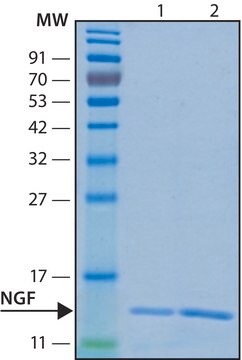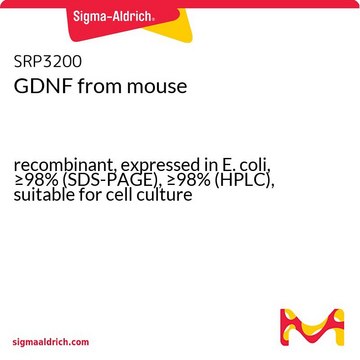おすすめの製品
product name
神経成長因子-2.5S from murine submaxillary gland, NGF-2.5S, lyophilized powder, suitable for cell culture
由来生物
mouse
品質水準
形状
lyophilized powder
有効性
0.1-30 ng/mL EC50 (using PC-12 cells)
分子量
26.5 kDa
包装
pkg of 4X25 μg
保管条件
avoid repeated freeze/thaw cycles
テクニック
cell culture | mammalian: suitable
UniProtアクセッション番号
輸送温度
dry ice
保管温度
−20°C
遺伝子情報
mouse ... Ngf(18049)
詳細
アプリケーション
- 後根神経節(DRG)を用いる成長円錐崩壊アッセイを実施するためのHam′s F-12培地において
- マイクロ流体チャンバー試験のための“プロセスコンパートメント” における培地サプリメントとして
- コリンアセチルトランスフェラーゼ(CHAT)発現に対するその効果を調べるための中期黄体細胞の処理
生物化学的/生理学的作用
その他情報
物理的形状
アナリシスノート
保管分類コード
11 - Combustible Solids
WGK
WGK 3
引火点(°F)
Not applicable
引火点(℃)
Not applicable
個人用保護具 (PPE)
Eyeshields, Gloves, type N95 (US)
適用法令
試験研究用途を考慮した関連法令を主に挙げております。化学物質以外については、一部の情報のみ提供しています。 製品を安全かつ合法的に使用することは、使用者の義務です。最新情報により修正される場合があります。WEBの反映には時間を要することがあるため、適宜SDSをご参照ください。
Jan Code
N6009-4X25UG:
N6009-25UG-LBL:
N6009-10UG:
N6009-4X25UG-LBL:
N6009-100UG:
N6009-4X25UG-PW:
N6009-BULK:
N6009-VAR:
試験成績書(COA)
製品のロット番号・バッチ番号を入力して、試験成績書(COA) を検索できます。ロット番号・バッチ番号は、製品ラベルに「Lot」または「Batch」に続いて記載されています。
この製品を見ている人はこちらもチェック
ライフサイエンス、有機合成、材料科学、クロマトグラフィー、分析など、あらゆる分野の研究に経験のあるメンバーがおります。.
製品に関するお問い合わせはこちら(テクニカルサービス)









